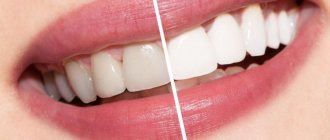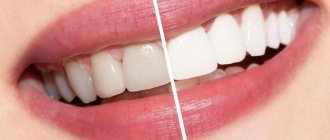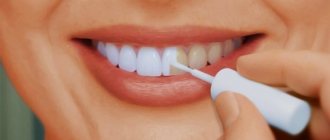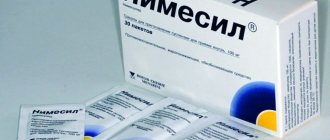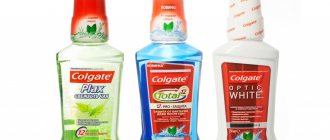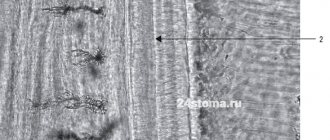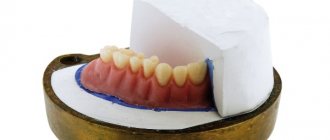Filtek composite is a modern filling material with a wide range of uses. It is indicated for treatment, filling cavities, and tooth restoration. The material is durable and can be used on any part of the row, withstanding chewing and other loads.
The composite is offered in several forms - these are standard sets with two syringes and a material in a universal “body” shade (A2 and A3), sets of four syringes with a composite for restoring dentin and enamel. There are professional maximum sets that include 12 shades, including “body” and a composite with a transparent effect. Filtek is very popular due to the following advantages:
- strength;
- minimal shrinkage;
- high level of aesthetics;
- long service life;
- maintaining a beautiful, natural shine;
- creating the required color effects, a large number of shades.
general information
Filtek is a composite material widely used for dental restoration.
It was developed by specialists from the famous ZM ESPE corporation at the beginning of this century. For the first time, specialists used the latest technologies - the introduction of nanoparticles, nanoclusters and their combinations into the composition of the composite. This ensured the material long-term strength and exceptional aesthetics.
A large number of shades of the composite are presented, and this makes it possible to use it on any part of the dentition. At the moment, Filtek is firmly established in the arsenal of modern dentists.
Material properties
According to the classification, Filtek Ultimate belongs to nanocomposites. The main properties of this filling material are:
- low shrinkage after light curing;
- excellent strength;
- sufficient wear resistance;
- plastic;
- easy adaptation to carious cavity;
- good packability;
- good polishability;
- long-term preservation of surface gloss;
- "chameleon" effect.
Advantages
The filling composite of the Filtek line is one of the latest generation materials. It is logical that it has a number of advantages over previous options:
- shrinkage after polymerization and exposure to light is minimized;
- high strength;
- duration of use as a filling;
- good fit into the required cavity;
- high polishing effect;
- long-lasting shine;
- the ability to create the desired color effect.
All these qualities have made this material indispensable in the work of modern dentists.
Indications for use
Filtek composites can be used if it is necessary to perform the following manipulations:
- restoration of all types of carious cavities according to Black on the frontal and chewing elements of the row;
- aesthetic restoration of teeth included in the smile zone;
- performing indirect restorations : fixing inlays, veneers, onlays;
- splinting teeth>;
- superstructure of the stump for further orthopedic treatment;
- restoration using sandwich technology.
Indications for use
Composite material is indicated for use in the following situations:
- to fill the cavity after treatment;
- building a stump before performing further actions (for prosthetics and other methods);
- splinting, treatment of periodontal diseases;
- restoration of the surface of the dentition;
- production of veneers, inlays.
Release form and composition
The basis of the Filtek filling material is acrylic polymer resins of various types. Each type of composite has its own specific composition , depending on the purpose of application.
To impart color to a future filling, fillers are used in the form of silicon and zirconium nanoparticles, and their combinations - nanoclusters. The sizes of these particles range from 0.6 to 20 nm.
The color of the future filling depends on the filler included in the base material. More precisely, it depends on the size and quantitative ratio of nanoparticles and nanoclusters in it. The smaller their size, the denser and more matte the filling will be.
Composite mass of various compositions, placed in syringes, is included in the package of ready-made kits for work. Depending on the goals and objectives, there are several varieties.
Single Shade Set
Single Shade is an introductory set for restoration with tones of one degree of transparency.
It consists of two 4-gram syringes with Body shades - A2 and A3, designed to restore the body of the tooth.
These types of composite have a slight degree of transparency and are used for single-color restorations.
In addition to syringes with the composite, the kit contains technical instructions for the correct use of the material.
Dual Shade Kit
This kit contains a set of 4 syringes. Available shades - 2 syringes for dentin restoration - A3, A4; 2 syringes for enamel restoration – A2, A3.
Additionally, the set contains an auxiliary scale for selecting the desired color. The kit is supplied with technical instructions.
Professional set
The professional set includes 12 syringes with different shades of the composite:
- 3 dentin colors – A2, A3 and B3;
- 4 Body shades – A2, A3, A3.5, B2;
- 4 enamel tones – A1, A2, A3, and W;
- 1 transparent shade – AT.
Along with the composite, the kit contains instructions for using the material and a special scale for determining the shade of the substance.
Filtek Z250
Available in separate 4 g syringes. It is a microhybrid material and contains an increased amount of nanoparticles. It has particularly high strength and adheres well to the walls of the tooth.
The range of applications is very wide:
- filling all types of cavities on the front and side teeth;
- performing veneers;
- splinting.
The color range of this type of composite includes 15 shades, which ensures its use in the restoration of any area of the dentition.
A filling made from Z 250 completely eliminates the possibility of recurrent caries.
Differences in composition
The composite is also based on organic resin. Unlike the Ultimate series, only bis-GMA, UDMA and bis-EMA can be found in the composition.
In addition to the matrix, the Z250 series has a different filler. It contains particles 0.5-5 microns in size.
Release form: 4 g syringe. The number of color options is much smaller; there is no division into dentin, enamel and “body”.
Differences in properties
This material also has the basic properties of composites, namely:
- satisfactory aesthetics;
- wear resistance;
- radiopacity;
- long-term preservation of the quality of the filling.
But due to the different size of the filler, the material has some disadvantages compared to the Ultimate series:
- higher shrinkage during polymerization;
- more complex application of material and its insufficient density;
- the quality of the restoration itself is lower;
- worse polishability;
- insufficient strength when used on complex and multi-level cavities.
Indications, methods of use and precautions are similar to the previous substance.
It is included in the kit
The filling material is packaged in syringes and disposable capsules.
Let's look at what the Filtek Z250 set consists of:
- 8 syringes, 4g each. A1, A2, A3, A3.5, B3, C2, D3, UD.
- Bottle with Single Bond adhesive - 2-6 ml.
- Scotchbond etching gel syringe - 3 ml.
- Trial set of Sof-Lex discs.
- Shade scale.
- Accessories.
Let's consider in what cases the use of a composite is possible.
Advantages of the material
Not every filling material has these advantages:
- The high level of density ensures excellent edge seal.
- Photopolymerizability.
- An alternative for the implementation of multi-layer restorations.
- After use, an excellent aesthetic appearance is guaranteed.
- Easy to polish.
- High level of wear resistance.
- Low shrinkage, about 2%.
- Easy to use, does not stick to tools.
- Large selection of shades.
Having such advantages, the material is very popular among dentists.
Rules for working with material
It is worth considering that Filtek Z250 contains methacrylates. There is a category of citizens who have a tendency to develop an allergic reaction to acrylic resins. It is necessary to adhere to the following recommendations when working with the material:
- Reduce exposure to the drug to reduce the risk of allergic reactions.
- Be especially careful when exposed to uncured resins.
- When working with the material, be sure to use protective gloves and non-contact equipment.
- If the filling composite gets on an unprotected area of the body, immediately wash it with running water and soap.
- Attention! Acrylates can penetrate gloves.
- If restoration material gets on the glove, it must be removed and thrown into the trash. Wash your hands thoroughly with soap. To continue working, you must wear new gloves.
- If the material gets into the eyes or other parts of the body, immediately rinse the area under running water.
- If there is prolonged contact of the material with soft tissues in the oral cavity, the area should also be rinsed generously with water.
- The time spent working with restoration material should be reduced to a minimum.
- Syringes with the composite should be stored at room temperature in tightly closed boxes, away from light.
Work technology
Let's consider what the technology for working with the Filtek Z250 material is. The instructions recommend the activities described below.
Preparatory procedures:
- Clean your teeth from plaque. You need to use pumice and water. This will help you determine the color correctly.
- Determine whether there are concomitant diseases and contraindications to the installation of a filling.
- Determine the depth of the restoration. The shade will depend on the thickness of the material.
Typically, the dental plate is divided into three parts:
- Cervical. Use material in yellow shades.
- Average. Yellowish, brownish and gray shades are used.
- Cutting edge. Use blue and gray tones.
For restoration, it is necessary to work with the material to determine the thickness and shape, as well as to select the required shade. A trial application will help you achieve optimal results.
Next, the tooth is isolated from the gum and cheek. To do this, use a rubber dam or cotton rolls with a saliva ejector.
Nanohybrid Z550
The filling composite FiltekZ550 is a highly filled material, which contains nanometers up to 5 microns in size and associated particles - nanoclusters, whose diameter does not exceed 10 nm. The photopolymer color range contains 12 shades .
The advantages of the nanohybrid are the following characteristics:
- high degree of adaptation to the walls of the carious cavity;
- good modelability;
- retention of shape until polymerization;
- strength and wear resistance.
The material can be used for the restoration of chewing and frontal elements of the row, however, according to experts, in appearance it is somewhat inferior to the Ultimate series.
From the video, learn about the new filling material from 3M ESPE.
Differences in composition
Filtek Z550 contains particles with a size of 0.5-5 microns and nanoclusters with a diameter of 0.6-10 nm. It is based on the same polymer resins as the Ultimate material.
Release form – syringe 4 g.
Differences in properties
The 550 series is a modification of the Z250 series. It differs from it in the presence of nanoparticles added to the composition, which improved some of its indicators:
- strength has become higher;
- improved wear resistance;
- insertion into the cavity has become easier and more convenient;
- modeling the filling surface has become easier.
But still, the content of miniparticles does not allow the Z550 to have the same high level of aesthetics as the Ultimate series. In addition, high shrinkage remains after polymerization of the material. The degree of polishability of the material also differs. For this composite it will be slightly lower.
Indications for use, precautions and methods of use correspond to previous photopolymers.
Universal restoration material Filtek Ultimate
Dispenser filled with Filtek Ultimate filling material, Enamel dispenser, shade B2, 3920B2E (1 piece, 4 g)
3M ESPE Filtek TM Ultimate Universal Restorative is a light-curing composite designed for use in the anterior and posterior regions. All shades are radiopaque. A dental adhesive, such as one from 3M ESPE, is used to permanently bond the restoration to the tooth structure. The material is available in a wide range of shades: Dentin, Body, Enamel, Translucent. The material is available in syringes.
Compound
The resin is slightly modified compared to Filtek tm Z250 Universal Restorative and Filtek tm Supreme Universal Restorative. This resin contains BiS-GMA, UDMA, TEGDMA and BIS-EMA resins. To reduce shrinkage, part of the TEGDMA resin of the Filtek TM Supreme XT material was replaced with PEGDMA.
The filler is a combination of free 20 nm silicon nanoparticles, 4 to 11 nm free zirconium particles, and silanized zirconium-silicon clusters (consisting of 20 nm silicon particles and 4-11 nm zirconium particles). In the shades Dentin, Enamel and Body, the cluster size ranges from 0.6 to 20 microns. By weight, filler is 72.5% (55.6% by volume) for Transluscent shades and 78.5% by weight (63.3% by volume) for other shades.
Indications for use
Restoration material Filtek TM Ultimate is indicated for:
- Direct restorations in the anterior and chewing regions (including occlusal surfaces)
- Stump superstructures
- Splinting
- Indirect restorations (including inlays - onlays and veneers)
Recommendations for choosing the color of Filtek tm Ultimate Universal Restorative material
1. After cleaning the tooth surface (carrying out professional hygiene), determine which colors you will need. Do this before preparing the tooth or installing a rubber dam. An overdried tooth will be brighter than a normal one. Thus, the color chosen on a dry tooth will be brighter than the normal shade after rehydration.
2. When choosing a color,
- If you plan to use one shade, choose the Body shade, focusing on the middle third of the crown of the tooth. Select the color as accurately as possible, also focusing on the middle third of the tooth on the VITA scale.
- If you plan to use more than one shade to accurately represent the tooth structure and obtain the best vitality of the restoration, use the shade wheel (described below) to determine which opaques to use. To decide on the choice of shade in a given opacity, you must:
— Select the Dentin (or Body) shade, focusing on the cervical area of the tooth. Select the color of the composite that is more suitable to the color of the cervical part of the tooth from the VITA shade.
— Select the Body shade, focusing on the middle third of the tooth crown, also focusing on the middle part of the tooth from the VITA shade
— Select an enamel shade, focusing on the incisal edge of the front tooth, or the tops of the cusps of the lateral teeth. Select the shade of the composite that more closely matches the central part of the tooth on the VITA scale
— A transparent shade (in the same light range) can be used to increase transparency and increase the “depth effect” of the restoration
3. Mock up the restoration before etching. The color of the composite can be affected by the thickness of its layer. Composites may change color after exposure. Place and illuminate the composite of the intended thickness over the area of the planned restoration. Obtain patient consent for the chosen color. Remove the mock-up using a probe.
4. Evaluate the color match of the scale and mock-up in different lighting conditions.
5. When grinding and polishing the restoration, imitate the surface morphology of natural teeth.
filtek bulk fill fluid composite material
The Dental-Shop company presents the innovative Filtek bulk fill 4862 dental fluid material, 2 syringes of 2 grams each
DESCRIPTION:
FILTEK BULK FILL (2 pcs, 2 g, 20 nozzles) Liquid-flowing composite material Filtek™ Bulk Fill BulkFill.
3M ESPE Filtek Bulk Fill flowable restorative material is a flowable, light-curing, low-viscosity radiopaque composite.
This low internal stress, flowable material is translucent and can be cured to a depth of 4mm.
Filtek Bulk Fill flowable material contains bis-GMA, UDMA, bis-EMA(6) and Procrylat composites. The filler used is a combination of ytterbium trifluoride with particles ranging in size from 0.1 to 5.0 microns and a zirconium-silicon mixture with particle sizes ranging from 0.01 to 3.5 nm. The proportion of inorganic filler is about 64.5% by weight (42.5% by volume).
INDICATIONS
- Base for direct restorations of classes 1 and 2
- Spacer for materials for direct restorations
- Pit and fissure sealant
- Restoration of minimally invasive prepared cavities (including small restorations in areas of occlusion that are not under load)
- Restoration of defects of classes III and V
- Blocking undercuts
- Elimination of minor enamel defects
- Minor defects in esthetic indirect restorations
- Repairing composite and acrylic temporary materials
- To restore the destroyed part of the tooth and when forming a coronal stump in cases where at least half of the coronal part of the tooth is preserved as a support
Advantages:
- Quick and convenient restoration of dentin in one portion up to 4 mm without layer-by-layer application for the lateral group of teeth
- Easy material adaptation due to controlled fluidity
- Radiopacity
- 4 available shades (A1, A2, A3, U-universal)
- High wear resistance and strength in the class of fluid materials applied in large portions
- Does not drain with restorations on the upper jaw
Equipment:
- Filtek Bulk FillPosterior - material for restoration of lateral teeth, 2 syringes of 2 grams each
Manufacturer: 3M ESPE
INSTRUCTIONS FOR USE Preparation
Cleaning. To remove plaque, teeth must be cleaned with a water-pumice suspension. Choice of shade. Before isolating a tooth, select the shade(s) of Filtek Bulk Fill flowable restorative material using the standard VITAPAN classic shade chart. When using sealants or core restoration materials, it may be preferable to use contrasting shades to differentiate the materials. Note: Because Filtek Bulk Fill is a translucent material, the area of restoration, the color of the underlying tooth or adjacent areas of the restoration may affect the final appearance of the base/liner. Insulation. The preferred method of isolation is a rubber dam. However, you can also use cotton swabs in conjunction with a saliva ejector. Directions 1. Interdental matrix. Proper use of the interdental matrix is necessary to ensure proper sealing of the tooth contact area. To achieve a tight fit of the gums and establish the desired distance between the teeth, taking into account the thickness of the dental matrix, wedges should be used. It is preferable to use a pre-modeled sectional matrix. However, if necessary, an ultra-soft ring matrix can also be used. The matrix must be ground to form a proper proximal contour because the flowable Filtek Bulk Fill will not hold it in place during placement.
2. Pulp protection. If pulp exposure has occurred or the situation requires direct pulp capping, apply a small amount of calcium hydroxide to the exposed area, followed by 3M ESPE Vitrebond or Vitrebond Plus light-curing glass ionomer material. Vitrebond or Vitrebond Plus liner/backing material can also be used to cover deep cavity excavation areas.
3. Adhesive system. To embed Filtek Bulk Fill into the tooth structure, it is recommended to use the 3M ESPE adhesive system. For complete product information and associated safety precautions, please refer to the adhesive system instructions for use.
4. Application. 4.1. Application using a syringe. Filtek Bulk Fill can be applied using a dispenser tip. 4.1.1. Staff and patients are advised to wear safety glasses when using the handpiece. 4.1.2. Tip preparation. Remove the cap and set aside. Gently bend the tip directly onto the syringe. Without pointing the syringe toward personnel or the patient, dispense a small amount of flowable Filtek Bulk Fill to ensure patency of the system. 4.1.3. If there is an obstruction, remove the tip and squeeze a small amount of Filtek Bulk Fill directly from the syringe. If there is a visible blockage in the syringe opening, it must be removed. Reinstall the dispensing tip and try dispensing material again. Filtek Bulk Fill, a fluid-flowing restorative material, can be squeezed onto a mixing plate and applied using a suitable tool.
4.2. Single use capsule. Insert the capsule into the 3M ESPE Restorative Dispenser. Follow separate dispenser instructions and associated safety precautions.
5. Application. 5.1. Avoid direct exposure to intense light on the work area. Exposing the paste to intense sunlight may cause premature polymerization.
5.2. Distribution of flowable material Filtek Bulk Fill. Start at the deepest section of the preparation: keep the tip close to the surface. After dispensing material, slowly lift the tip above the material being dispensed to minimize air entrapment. Do not allow the tip to become immersed in the material. To treat proximal areas, press the tip against the matrix to force material into the proximal contour. 5.2.1. Use as a lining/base. For universal or composite material for posterior teeth, at least a 2-mm layer of the cavitary interface must be left. Thanks to the bite layer, strength, wear resistance, as well as aesthetic qualities necessary for the restoration of lateral teeth are achieved. 5.2.2. Restoration of the tooth stump. Inject the material into the undercut area, around pins, crowns, and then inject the drug. 5.2.3. Application of sealant. Apply the material to the surface to be prepared.
5.3. Carry out light curing as described in section 6.
6. Polymerization. The polymerization of this product is provided under the influence of light from a halogen or LED lamp with a minimum intensity of 550 mW/cm2 in the range of 400–500 nm. Cure each layer of material by illuminating its entire surface with high intensity light from a source such as the 3M ESPE Light Curer. During polymerization, keep the light guide as close to the material to be polymerized as possible. df
7. Completion of restoration. 7.1. Use as a lining/base. Apply a composite restorative material, such as Filtek Ultimate Universal, directly onto the cured flowable Filtek Bulk Fill. Follow manufacturer's instructions regarding setting, curing, grinding, occlusal check, polishing.
7.2. Sealing of pits and fissures. Carefully remove the inhibited layer remaining after light polymerization using pumice or polishing paste.
7.3. Stump extension. 7.3.1. Bulk Fill restorative material is compatible with traditional impression materials when removing the inhibitory layer. 7.3.2. Bulk Fill restorative material should be moistened with saliva or lubricant to prevent chemical cure. 7.3.3. Traditionally used temporary cement does not adhere to Bulk Fill material.
7.4. Final processing for direct restoration. 7.4.1. Polish the surfaces of the filling with diamond or carbide finishes, burs or stones. 7.4.2. Check occlusion with articulation paper. Check the center and side contacts while driving. Carefully adjust the occlusion, removing excess material with a fine-grit diamond bur or stone.
Preparatory activities
Working with the proposed composites requires certain preparatory work.
The first step is standard brushing of teeth using normal hygiene products. Then the dentist performs a complete sanitation of the oral cavity. It includes treatment, inflammation removal and professional cleaning.
The final stage of preparation is the correct selection of the shade of the proposed filling. It is executed in the following order:
- Dividing the tooth into segments. The body of the tooth has some heterogeneity in color tone in different areas.
To reconstruct it correctly, the entire area is divided into 3 segments. Each of them is filled with a composite that matches the color for the given area.The area near the neck of the tooth is restored with yellow material. For the middle, composites of gray, yellow or brown color are used. The upper (incisal) border is made in grayish or blue shades.
- Selection of shade. The color and its saturation of each of these areas is checked using an auxiliary color scale, corresponding to that part of it that is identical to the thickness and color of the desired area of the tooth.
- Checking the correct selection. To control the correct choice of shade, the composite is applied to the desired location.
After its polymerization, a visual assessment is made using different types of light. If necessary, adjustments are made until the desired effect is achieved. - Isolation and protection of the treated area from other teeth is carried out using a latex napkin (rubber dam). If it is not available, then the use of cotton swabs or a saliva ejector is used.
This concludes the preparatory work before the restoration of damaged surfaces begins. It must go through the full cycle, regardless of which method of tooth reconstruction is chosen.
Preparation and restoration
Restoration requires preliminary preparation methods, including professional teeth cleaning, removal of inflammatory processes, and dental treatment.
The next important stage of preparation is the selection of shade:
- Teeth are divided into segments, since the shade for the frontal and lateral areas may differ. Yellowish shades are used for the neck of the tooth, brown, yellow and gray shades for the middle part, and blue and grayish shades for the incisal part.
- The selection of shade and color saturation is carried out, identical to natural.
- Selection control. A small amount of the composite is applied to the enamel to compare the shade and naturalness of the selected color;
- Protection, isolation of the working area from surrounding tissues. For this, special napkins, rubber dams and other methods are used.
Restoration is performed using two methods - direct and indirect methods.
The direct method requires the following steps:
- surface treatment, insertion of a gasket impregnated with drugs into the cavity;
- insertion of a matrix between adjacent teeth;
- etching of enamel, dentin;
- application of an adhesive agent, its polymerization;
- applying the composite material in layers, each layer must be illuminated with a special lamp for polymerization;
- the syringe closes immediately, which reduces the time of contact of the material with air;
- surface formation using finishers, burs;
- correction of fillings using articulating paper;
- grinding, polishing the filling.
The indirect method has similar steps to the direct one, but also additionally requires the following actions:
- processing the tooth and taking an impression to make a plaster model;
- manufacturing a structure with layer-by-layer application of material and polarization;
- adjustment of the structure, polishing and testing on the model;
- checking cavity processing, creating roughness for improved adhesion;
- installation of the product, fastening with dental cement.
Restoration methods
After all the preparatory work has been completed, a method for restoring lost teeth or dental surfaces is selected. Two main methods are used .
Direct recovery
Dental restoration using the direct technique is carried out as follows:
- Preparation of a carious cavity. Dead tissue is removed from the affected hole using standard cavity treatment techniques.
- Pulp protection. When the pulp is exposed, calcium hydroxide and spacer material are applied.
- Fixation of the matrix, etching of enamel, application of adhesive and polymerization. To avoid problems at this stage, you should follow the recommendations of the manufacturer of the materials used.
- Composite preparation. The required amount of photopolymer is squeezed out of the syringe onto a special mixing bar, after which the syringe is closed with a cap, and the extracted gel is protected from sunlight.
- Application of filling agent and polymerization. The material is introduced into the cavity layer by layer, carefully distributed throughout it.
Each layer is light-polymerized using a special lamp. The duration of light exposure depends on the type and transparency of the shade used. - Contouring of the filling. The cured composite is processed using burs or finishers, after which the occlusion is determined using carbon paper. If necessary, excess material is carefully removed with a special tool.
- Polishing. The surface of the filling is ground and polished, after which the restoration is considered complete.
Indirect restoration
Indirect restoration includes the following stages of work:
- Preparatory work as described above. Selecting the shade and cleaning the surface.
- The tooth is processed for the chosen type of structure.
- The impression is taken.
- A plaster model is made in the laboratory.
- A layer of separator is applied to it so that it can be easily removed.
- As with direct restorations, the composite is applied in layers.
- The design is polished and tried on the model.
- The prosthesis is installed in the patient’s oral cavity and fixed. If revision is necessary, it is returned to the laboratory.
- It is necessary to create a non-smooth surface on the inner surface.
- The prosthesis must be cleaned in soapy water using ultrasound.
- Rinse under running water and dry thoroughly.
- Then the prosthesis is fixed with composite cement.
Some tips for working with Filtek Z250 material:
- Each layer is applied layer by layer.
- For the shade “Filtek Z250” UD, the layer should be no thicker than 2.0 mm.
- Curing time is 20 seconds for shades A1, A2, A3, A3.5, A4, B1, B2, B3, C3, D3, I.
- Each layer should be polymerized.
- Curing time is 30 seconds for shades B0.5, C4, UD.
- Do not create layers thicker than 2.5 mm.
When dealing with modern restoration materials, there are certain rules. This also applies to Filtek Z250. We will consider a description of the subtleties that need to be taken into account when working.
Recommendations and warnings
The presence of polymer resins in the Filtek composite requires careful handling of the material. It is necessary to ensure that the substance does not come into contact with the skin , so manufacturers recommend carrying out the filling procedure with gloves and carefully isolating the soft tissues of the patient’s oral cavity.
If the composite comes into accidental contact with your skin, you should immediately wash your hands with plenty of water. Contact of a substance with a glove requires removal of the glove, washing of hands with soap and use of a new pair of gloves.
Filtek filling material must be stored in tightly closed syringes for 3 years from the date of manufacture.
To ensure that the quality characteristics of the drug are preserved, exposure to direct sunlight should be avoided.
special instructions
Syringes should be stored at room temperature with the lid tightly closed. Shelf life – 3 years. It is necessary to completely exclude exposure to light, as the material may lose its properties. Also, the composite should be kept away from products containing eugenol.
Due to the content of polymer resins, there is a possibility of developing allergies upon direct contact with the material. To reduce the risk of allergic reactions, the composite must be used with protective gloves, completely eliminating any contact.
In case of contact with skin, wash it immediately under running water. If the material ends up on the gloves, they are removed and the hands are treated with soap. Then new gloves are put on.
Recommendations
The use of acrylic pastes for treatment requires compliance with a number of recommendations:
- the doctor must use protective gloves and non-contact equipment;
- Direct contact of the product and open areas of the skin or mucous membrane should be avoided; if the paste gets in contact, wash with water and soap;
- if the material gets on gloves, the product is no longer used, the gloves must be replaced with new ones;
- syringes are stored only in special, tightly closed boxes;
- the time of contact of the product with other surfaces and air during application is minimized.
The cost of materials depends on the form of release. Depending on the type, the cost of syringes ranges from 2300 rubles, standard sets - 10-15 thousand rubles, maximum sets - 22-29 thousand rubles.
Price
The price of the Filtek composite material depends on the kit’s configuration , so for the Single Shade and Dual Shade packages a specialist will have to pay from 10 to 12 thousand rubles. A professional kit will cost 24-27 thousand rubles.
The cost of a Filtek filling for a patient depends on the volume of restoration performed. So, restoring the surface of one tooth will require 1500-1650 rubles. For the restoration of two surfaces you will have to pay about 1750-1900 rubles.
Bottom line
Now it has become clear to you that Filtek is a nanocomposite of versatile use, which can be used not only for teeth intended for chewing, but with its help you can also restore the front teeth.
Now you have become aware of all the advantages of this composite, and it will not be difficult for you to choose the material that suits you, both for the restoration of chewing teeth and for the aesthetic restoration of the front teeth.
Sources:
- https://www.vash-dentist.ru/lechenie/zubyi/plombyi/vozmozhnosti-materiala-filtek.html
- https://dentazone.ru/preparaty-oborudovanie/materialy/filtek.html
- https://zubovv.ru/lechenie/zubyi/plombyi/svoystva-materiala-filtek.html
- https://FB.ru/article/420332/filtek-z-obschaya-informatsiya-forma-vyipuska-sostav-naznachenie-tehnologiya-provedeniya-rabotyi-pokazanie-i-protivopokazaniya-k-primeneniyu
- https://El-dent.ru/id/filtek-ultimate-kompozit-enamel-b2e-3920b2e-3m.html
- https://medicina-top.ru/%D1%81%D0%B2%D0%B5%D1%82%D0%BE%D0%B2%D0%B0%D1%8F-%D0%BF%D0% BB%D0%BE%D0%BC%D0%B1%D0%B0-%D1%84%D0%B8%D0%BB%D1%82%D0%B5%D0%BA/
This is interesting: Consequences of a cyst in the gum of a tooth - why is this phenomenon dangerous?


